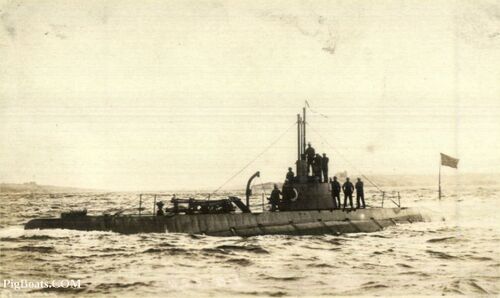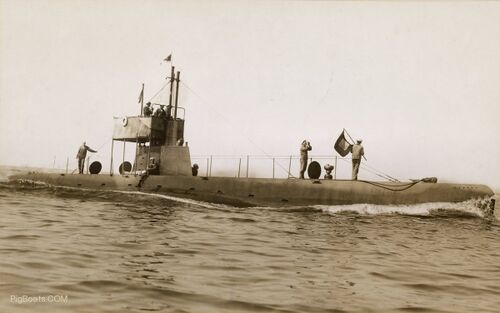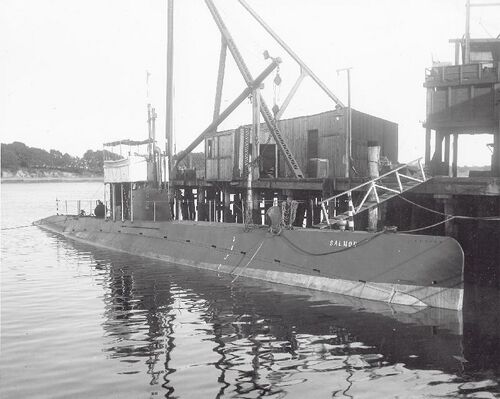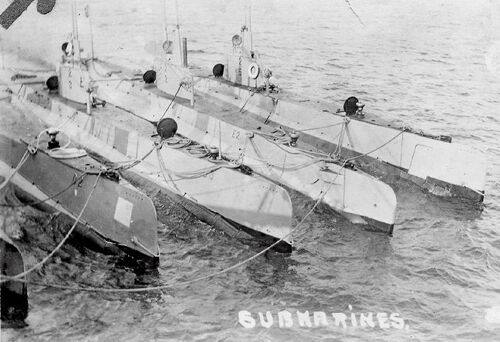D-class: Difference between revisions
Pbcjohnston (talk | contribs) (→General D-class photos: Added general section) |
Pbcjohnston (talk | contribs) mNo edit summary |
||
| (11 intermediate revisions by the same user not shown) | |||
| Line 1: | Line 1: | ||
[[File:D-Boat Header 1.jpg|center]] | [[File:D-Boat Header 1.jpg|center]] | ||
=== <big>Design, Construction, and Naming Notes</big> === | === <big>Design, Construction, and Naming Notes</big> === | ||
<div style="text-align: justify;"><span style="color:#00008B">The three D-class harbor defense submarines were built to an Electric Boat Company Design at the Fore River Shipbuilding Company in Quincy, MA. All three boats were commissioned in the Navy with their original "fish" names. On November 17, 1911 the Navy changed its naming convention for submarines and these boats were renamed with their D-class names. They had their original general submarine series designations changed to the SS series on July 17, 1920.</span> | <div style="text-align: justify;"><span style="color:#00008B">The three D-class harbor defense submarines were built to an Electric Boat Company Design at the Fore River Shipbuilding Company in Quincy, MA. They were enlarged C-class boats, and for the first time in a U.S. submarine, the internal space was divided by watertight bulkheads, making these boats more survivable. Narwhal and Grayling had four compartments (torpedo room, forward battery/berthing & control room, after battery/messing, and engine room. Salmon was fitted with only two bulkheads, leaving one large compartment in the middle that made up the forward battery, control room, and after battery. This was done to allow space for a new walk-around periscope, a big improvement over the fixed eyepiece units of the previous boats. | ||
All three boats were commissioned in the Navy with their original "fish" names. On November 17, 1911 the Navy changed its naming convention for submarines and these boats were renamed with their D-class names. They had their original general submarine series designations changed to the SS series on July 17, 1920. | |||
In early 1918 the perceived need for submarines to support the war effort pushed the Navy to consider re-engining the D-class boats with diesels. After a bit of bureaucratic waffling, the effort was approved. Electric Boat's engine subsidiary NELSECO was already at capacity so the Lyons-Atlas Engine Company of Indianapolis was sub-contracted to build an eight cylinder, 240 bhp engine for the effort. These model 120-V4FS engines were built and sent off to the Philadelphia Navy Yard where the work was performed. D-1's re-engining was completed in October 1918, but the end of the war the next month deflated the need and D-2 and D-3's work was not completed until early 1919. | |||
The newer and better engines could not change the fact that tactics and technology had rendered the D-class boats largely obsolete by the early 1920's. They were all placed in reserve in 1921, never to return to active service. They were scrapped a year later.</span></div> | |||
[[File:Red bar sub new.jpg]] | [[File:Red bar sub new.jpg]] | ||
=== <big>Narwhal/D-1 (Submarine No. 17, later SS-17)</big> === | === <big>Narwhal/D-1 (Submarine No. 17, later SS-17)</big> === | ||
[[File:D-1 off port bow.jpg|left| | [[File:D-1 off port bow.jpg|left|500px|Photo in the private collection of Ric Hedman.]] | ||
<div style="text-align: justify;"><span style="color:#00008B">Photo of the D-1 in transit on the surface, location not known for sure but suspected to be off the New England shore. The date is approximately 1911-1912. The purpose of the truss-like structure on the fore deck is not known. It is possibly the disassembled pipe frame of the temporary bridge structure. The deck cover over the Torpedo Loading Hatch is partly open and resting on the objects. The man who is the highest on the bridge is the helmsman steering the submarine from a helm wheel mounted to the aft side of the periscope shears. Quite possibly the Captain and the Officer of the Deck just behind the helmsman. There is a bit of the swell running as the D-1 noses into a wave.</span> | <div style="text-align: justify;"><span style="color:#00008B">Photo of the D-1 in transit on the surface, location not known for sure but suspected to be off the New England shore. The date is approximately 1911-1912. The purpose of the truss-like structure on the fore deck is not known. It is possibly the disassembled pipe frame of the temporary bridge structure. The deck cover over the Torpedo Loading Hatch is partly open and resting on the objects. The man who is the highest on the bridge is the helmsman steering the submarine from a helm wheel mounted to the aft side of the periscope shears. Quite possibly the Captain and the Officer of the Deck just behind the helmsman. There is a bit of the swell running as the D-1 noses into a wave.</span> | ||
| Line 15: | Line 20: | ||
=== <big>Grayling/D-2 (Submarine No. 18, later SS-18)</big> === | === <big>Grayling/D-2 (Submarine No. 18, later SS-18)</big> === | ||
[[File:Grayling w crew c1909-1.jpg|left| | [[File:Grayling w crew c1909-1.jpg|left|500px|National Archives photo]] | ||
<div style="text-align: justify;"><span style="color:#00008B"> | <div style="text-align: justify;"><span style="color:#00008B">Grayling underway during maneuvers with her sister boats, likely in Cape Cod Bay in the summer of 1910 or 1911. The two men on the forward deck are practicing with semaphore flags. One man moves the flag to the correct position for the signal, the other uses binoculars to read the response. The object between the two men is the [[Allied Signal Bell|'''Allied Signal Bell''']], an underwater signaling device used to communicate with other submerged submarines. | ||
At the top of the photo can be seen the boat's periscopes. These are fixed height periscopes meaning they neither raise or lower but they do rotate. They are positioned so both can be used at the same time and not interfere with the view of the other. | |||
Between them is the ship's air operated whistle. At the top of the #2 periscope is the Submarine Division Three Pennant meaning she is the SUBDIV THREE flagship. Normally this is where the submarine's commissioning pennant would be flown from. | |||
Also attached to the #2 periscope, since it neither raises nor lowers, is a small yardarm with hoists for signal flags to be flown from. Heavy stays can be seen fore and aft holding the periscopes rigid and preventing the barrels from warping, destroying the optics.</span> | |||
[[D-2|See More D-2 photos]] | [[D-2|See More D-2 photos]] | ||
[[File:Red bar sub new.jpg]] | [[File:Red bar sub new.jpg]] | ||
<div style="text-align: justify;"><span style="color:#000000"> | |||
=== <big>Salmon/D-3 (Submarine No. 19, later SS-19)</big> === | === <big>Salmon/D-3 (Submarine No. 19, later SS-19)</big> === | ||
[[File:D3dock1.jpg|left| | [[File:D3dock1.jpg|left|500px|Photo courtesy of Wendy Gulley at the Submarine Force Library & Museum]] | ||
<div style="text-align: justify;"><span style="color:#00008B">Salmon moored at an unknown location, sometime between September 8, 1910 and November 17, 1911. The D-class boats were the last of the EB designs built without bow diving planes. The growing size of the boats made horizontal depth control while submerged much more difficult. Bow planes provided precise depth control, overriding the increasing hydrodynamic effect that the longer hulls had.</span | <div style="text-align: justify;"><span style="color:#00008B">Salmon moored at an unknown location, sometime between September 8, 1910 and November 17, 1911. The D-class boats were the last of the EB designs built without bow diving planes. The growing size of the boats made horizontal depth control while submerged much more difficult. Bow planes provided precise depth control, overriding the increasing hydrodynamic effect that the longer hulls had.</span> | ||
[[D-3|See More D-3 photos]] | |||
[[File:Red bar sub new.jpg]] | [[File:Red bar sub new.jpg]] | ||
=== <big>General D-class photos</big> === | === <big>General D-class photos</big> === | ||
[[File:D2d3e2d1.jpg|left| | [[File:D2d3e2d1.jpg|left|500px|Photo courtesy of Wendy Gulley at the Submarine Force Library & Museum]] | ||
<div style="text-align: justify;"><span style="color:#00008B">Left to right is D-2, D-3 and D-1, along with their near sister [[E-class|E-2]] (2nd from right) at a pier somewhere near New York City, approximately 1915. On the far left is another submarine, possibly E-1. The E-class submarines were essentially diesel powered D-boats with bow planes, and thus the two classes frequently operated together.</span | <div style="text-align: justify;"><span style="color:#00008B">Left to right is D-2, D-3 and D-1, along with their near sister [[E-class|'''E-2''']] (2nd from right) at a pier somewhere near New York City, approximately 1915. On the far left is another submarine, possibly E-1. The E-class submarines were essentially diesel powered D-boats with bow planes, and thus the two classes frequently operated together.</span> | ||
[[General D-class photos|See more General D-class photos.]] | [[General D-class photos|See more General D-class photos.]] | ||
[[File:Red bar sub new.jpg]] | [[File:Red bar sub new.jpg]] | ||
<center>[[Submarine Classes|Return to the Submarine Classes page]]</center> | |||
[[File:Red bar sub new.jpg]] | |||
<center> | |||
Page created by:<br> | |||
<span style="color:#00008B"> | |||
<small>Ric Hedman & David Johnston<br> | |||
1999 - 2023 - PigBoats.COM<sup>©</sup><br> | |||
Mountlake Terrace, WA, Norfolk, VA<br> | |||
webmaster at pigboats dot com</small> | |||
</center> | |||
[[File:Subs bottom line 2.jpg]] | |||
Latest revision as of 16:17, 25 September 2024

Design, Construction, and Naming Notes
All three boats were commissioned in the Navy with their original "fish" names. On November 17, 1911 the Navy changed its naming convention for submarines and these boats were renamed with their D-class names. They had their original general submarine series designations changed to the SS series on July 17, 1920.
In early 1918 the perceived need for submarines to support the war effort pushed the Navy to consider re-engining the D-class boats with diesels. After a bit of bureaucratic waffling, the effort was approved. Electric Boat's engine subsidiary NELSECO was already at capacity so the Lyons-Atlas Engine Company of Indianapolis was sub-contracted to build an eight cylinder, 240 bhp engine for the effort. These model 120-V4FS engines were built and sent off to the Philadelphia Navy Yard where the work was performed. D-1's re-engining was completed in October 1918, but the end of the war the next month deflated the need and D-2 and D-3's work was not completed until early 1919.
The newer and better engines could not change the fact that tactics and technology had rendered the D-class boats largely obsolete by the early 1920's. They were all placed in reserve in 1921, never to return to active service. They were scrapped a year later.Narwhal/D-1 (Submarine No. 17, later SS-17)

Grayling/D-2 (Submarine No. 18, later SS-18)

At the top of the photo can be seen the boat's periscopes. These are fixed height periscopes meaning they neither raise or lower but they do rotate. They are positioned so both can be used at the same time and not interfere with the view of the other.
Between them is the ship's air operated whistle. At the top of the #2 periscope is the Submarine Division Three Pennant meaning she is the SUBDIV THREE flagship. Normally this is where the submarine's commissioning pennant would be flown from.
Also attached to the #2 periscope, since it neither raises nor lowers, is a small yardarm with hoists for signal flags to be flown from. Heavy stays can be seen fore and aft holding the periscopes rigid and preventing the barrels from warping, destroying the optics.
Salmon/D-3 (Submarine No. 19, later SS-19)

General D-class photos

See more General D-class photos.
Page created by:
Ric Hedman & David Johnston
1999 - 2023 - PigBoats.COM©
Mountlake Terrace, WA, Norfolk, VA
webmaster at pigboats dot com